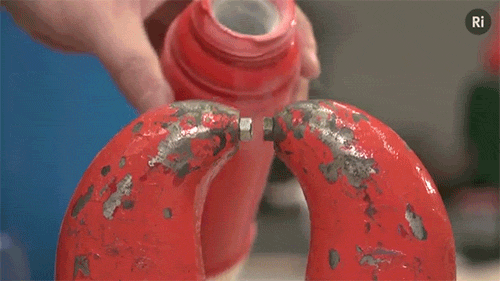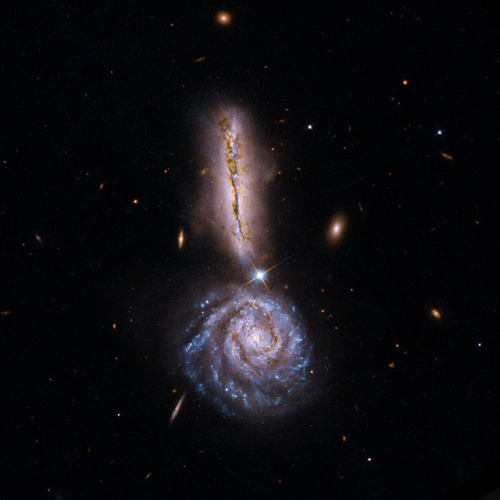In “Float” Artist Susi Sie Uses Water And Oil To Create A Whimsical Landscape Of Bubbles And Droplets.
In “Float” artist Susi Sie uses water and oil to create a whimsical landscape of bubbles and droplets. Coalescence is a major player in the action, though Sie uses some clever time manipulations to make her bubbles and droplets multiply as well. Watching coalescence in reverse feels like seeing mitosis happen before your eyes. (Video and image credit: S. Sie)



More Posts from Riekod and Others


Liquid oxygen is magnetic
Liquid oxygen sticks between the poles of a strong magnet until it boils away into its gas state. This is because it has unpaired electrons, which make each oxygen molecule a tiny magnet with a dipole. Normally, when oxygen is in a flask or in the air, these microscopic magnets point in all directions, cancelling out and meaning that there’s no net magnetic field. When it pours over the permanent magnet, the magnetic molecules all slightly align, creating an induced magnetic field, which reacts with the permanent magnet, making the oxygen stick to the poles. This is called paramagnetism. Click here to watch the video.

VV 340, pair of interacting galaxies in Boötes. The two galaxies shown here are in the early stage of an interaction that will eventually lead to them merging in millions of years.
Credit: NASA/STScI/NRAO/A.Evans et al
Productivity culture will deceive you (especially if you are particularly high-functioning or a former Gifted Kid) into thinking that any use of your time that can’t be monetized or leveraged for your personal advancement is worthless, and I’m here to tell you that’s the devil talking. Do shit because you like it.
Solar System: 10 Things to Know
Movie Night
Summer break is just around the corner. Hang a sheet from the clothesline in the backyard and fire up the projector for a NASA movie night.
1. Mars in a Minute

Back in the day, movies started with a cartoon. Learn the secrets of the Red Planet in these animated 60 second chunks.
2. Crash of the Titans

Watch two galaxies collide billions of years from now in this high-definition visualization.
3. Tour the Moon in 4K

Wait for the dark of the waning Moon next weekend to take in this 4K tour of our constant celestial companion.
4. Seven Years of the Sun

Watch graceful dances in the Sun’s atmosphere in this series of videos created by our 24/7 Sun-sentinel, the Solar Dynamic Observatory (SDO).
5. Light ‘Em Up

Crank up the volume and learn about NASA science for this short video about some of our science missions, featuring a track by Fall Out Boy.
6. Bennu’s Journey

Follow an asteroid from its humble origins to its upcoming encounter with our spacecraft in this stunning visualization.
7. Lunar Landing Practice
Join Apollo mission pilots as they fly—and even crash—during daring practice runs for landing on the Moon.
8. Earthrise

Join the crew of Apollo 8 as they become the first human beings to see the Earth rise over the surface of the Moon.
9. Musical Descent to Titan

Watch a musical, whimsical recreation of the 2005 Huygens probe descent to Titan, Saturn’s giant moon.
10. More Movies

Our Goddard Scientific Visualization Studio provides a steady stream of fresh videos for your summer viewing pleasure. Come back often and enjoy.
Read the full version of this article on the web HERE.
Make sure to follow us on Tumblr for your regular dose of space: http://nasa.tumblr.com.



Often times you look at really pretty images of Supernova remnants (what is left after a supernova explosion) and are blown away by their magnificence. But the sad truth is that there are not a lot of these supernovas that we can observe in such great detail.
On the bright side, in general there are lots of supernovas to observe in the universe. And the above is a spectacular time-lapse of the Supernova SN 2015F illustrating how the Luminosity of a Supernova varies with time.
More:
Star snapped before and after nova explosion-BBC
Supernovas and Supernova remnants - Images








Amazing views from the International Space Station (ISS)

Saturn’s rings and our planet Earth and Moon in the same frame captured by nasa’s Cassini spacecraft 19 July. (source @nasa) *Out Pale Blue Dot*

Arp 188 and the Tadpole’s Tail

Drops that impact a very hot surface will surf on their own vapor, and ones that hit a very cold surface will freeze almost immediately. But what happens when the temperature differences aren’t so extreme? Scientists explored this (above) by dropping room-temperature water droplets onto a cool surface – one warmer than the freezing point but cooler than the dew point at which water condenses.
They found that impacting drops formed a triple halo of condensate (right). The first and brightest ring forms at the radius of the drop’s maximum extent during impact. The second band forms from water vapor that leaves the droplet at impact. As that vapor cools, it condenses into a second band. The final, dimmest band forms as the droplet stabilizes and cools. It’s the result of water vapor near the droplet continuing to cool and condense. (Image and research credit: Y. Zhao et al.; via Nature News; submitted by Kam-Yung Soh)
-
 floppy--bones reblogged this · 3 years ago
floppy--bones reblogged this · 3 years ago -
 meat-ice-cream liked this · 3 years ago
meat-ice-cream liked this · 3 years ago -
 holdonimblooming liked this · 3 years ago
holdonimblooming liked this · 3 years ago -
 cannolipony liked this · 3 years ago
cannolipony liked this · 3 years ago -
 c0zycolors liked this · 3 years ago
c0zycolors liked this · 3 years ago -
 clnclm reblogged this · 3 years ago
clnclm reblogged this · 3 years ago -
 sundrop-beeps liked this · 3 years ago
sundrop-beeps liked this · 3 years ago -
 polyurethane liked this · 3 years ago
polyurethane liked this · 3 years ago -
 perfectlynormalparadise reblogged this · 3 years ago
perfectlynormalparadise reblogged this · 3 years ago -
 theodorebasmanov liked this · 3 years ago
theodorebasmanov liked this · 3 years ago -
 gluptuousvein liked this · 3 years ago
gluptuousvein liked this · 3 years ago -
 echidnana liked this · 3 years ago
echidnana liked this · 3 years ago -
 trans-surak liked this · 3 years ago
trans-surak liked this · 3 years ago -
 floral-botanist reblogged this · 3 years ago
floral-botanist reblogged this · 3 years ago -
 floral-botanist liked this · 3 years ago
floral-botanist liked this · 3 years ago -
 sensoryserenity reblogged this · 3 years ago
sensoryserenity reblogged this · 3 years ago -
 ketazet liked this · 4 years ago
ketazet liked this · 4 years ago -
 aranealux liked this · 4 years ago
aranealux liked this · 4 years ago -
 supreeto0o liked this · 4 years ago
supreeto0o liked this · 4 years ago -
 mutato-nomine-music liked this · 4 years ago
mutato-nomine-music liked this · 4 years ago -
 profanities-of-common-sense reblogged this · 4 years ago
profanities-of-common-sense reblogged this · 4 years ago -
 techjum reblogged this · 4 years ago
techjum reblogged this · 4 years ago -
 meticulousmaker liked this · 4 years ago
meticulousmaker liked this · 4 years ago -
 lsdrew reblogged this · 5 years ago
lsdrew reblogged this · 5 years ago -
 enceladus6 liked this · 6 years ago
enceladus6 liked this · 6 years ago -
 9milwaukee liked this · 6 years ago
9milwaukee liked this · 6 years ago -
 antoineclp liked this · 6 years ago
antoineclp liked this · 6 years ago -
 fuzzkaizer liked this · 6 years ago
fuzzkaizer liked this · 6 years ago -
 thorncube liked this · 6 years ago
thorncube liked this · 6 years ago -
 mzteeeyed reblogged this · 6 years ago
mzteeeyed reblogged this · 6 years ago -
 cronachenoiose liked this · 6 years ago
cronachenoiose liked this · 6 years ago